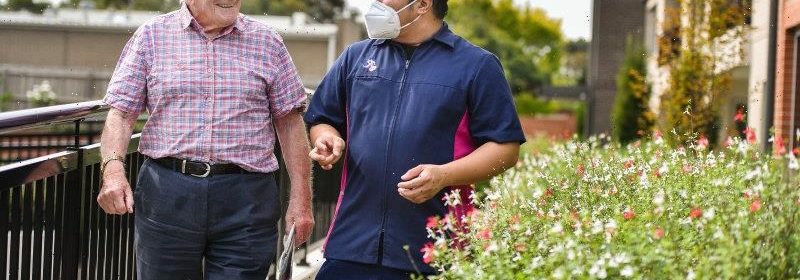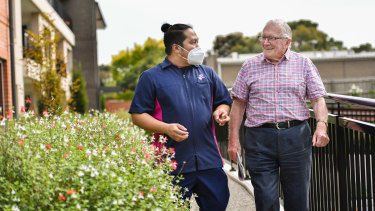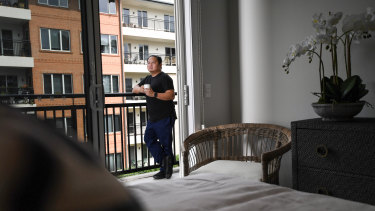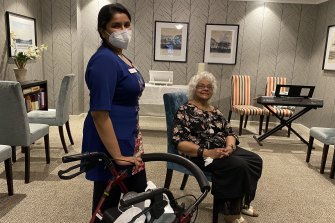‘They become your family’: the aged care workers living on the job

For our free coronavirus pandemic coverage, learn more here.
Many people during the pandemic have struggled to separate life and work. So, it’s surprising to hear aged care worker Joeben Roxas say his wellbeing has improved by moving into his workplace full-time.
“They say work-life balance is important, and I can only get it here,” the 43-year-old says, sipping a cup of tea on the balcony of his furnished worker’s apartment, waving to other aged care residents watering plants on their balconies.
“Outside you just sleep, you eat, you drive to and from work.”
Aged care worker Joeben Roxas with resident Bernie Hasell. Joeben has moved into the aged care facility where he works.Credit:Joe Armao
Mr Roxas is one of 50 staff members who have lived on-site across two aged care facilities in Melbourne’s south-east at various times during the pandemic. The provider, Ryman Healthcare, offered the option to its workforce who live with housemates in high COVID-risk jobs.
Ryman Healthcare is one of a handful of operators to implement the unusual practice, as the sector continues to be plagued by staff shortages due to workers becoming infected with COVID-19.
Data released weekly by the federal government shows there were 2550 COVID-positive aged care residents and 2572 positive staff across 645 active aged care outbreaks as of Thursday night.
More than 70residents have died already this year, accounting for more than a third of all aged care deaths since the beginning of the pandemic.
Nellie Melba Retirement Village in Wheelers Hill, where Mr Roxas works, was COVID-free until the Omicron variant appeared. Eleven residents tested positive in late January – all have since recovered.
As the facility this weekend begins allowing in-room family visits and resident outings again, workers like Mr Roxas are staying voluntarily locked in.
“It’s our own decision to not put ourselves at risk,” he says. “I can’t actually bear it, the thought of bringing something inside.”
Aged care worker Joeben Roxas picture on the balcony of his on-site apartment.Credit:Joe Armao
Usually residing in Cranbourne in a house with a nurse, a fellow aged care worker and a tradie, Mr Roxas took up the offer to move into the 400-person facility for five months straight last year during lockdowns. A month ago, he moved in again.
Although staff aren’t paid more to move in, there are no costs associated with staying on-site. Mr Roxas says he spends his days off with residents chatting in the cafe and playing table tennis or lawn bowls – activities he said he wouldn’t have time to do in the “outside world”.
“Honestly, it’s not work anymore,” he says.
Despite Mr Roxas’ cheer, he and other workers say conditions have been tough. Workers are doing extra shifts to fill in for sick colleagues while looking after residents suffering from months of little or no proper contact with family – all while sweating for eight hours or more under plastic protective gear.
The Omicron wave is still being keenly felt in aged care: the army has been deployed to help fill gaps at 40 facilities across the country while, at Ryman Health, marketing and sales staff have been kitted up in PPE to collect dirty washing, deliver meals to residents and clean high-touch surfaces.
Another on-site worker, registered nurse Shiv Ashok, says the last month spent living inside the facility has been lonely compared to her five-person share house in Glen Waverley.
“I do like having my own living space here though,” she says. On-site workers live in self-contained apartments, in the same building as residents. It takes about three minutes to walk from her flat to the nursing home’s high-care area, where she works.
Ms Ashok works four to five days a week on night shifts, spending her mornings and days off reading, watching TV and video-calling friends and family in Australia and her home country Sri Lanka.
Like Mr Roxas she only ventures out of the facility to get groceries, and is holding off seeing family and friends entirely for now.
Registered nurse Shiv Ashok with aged care resident Scarlett Joseph.Credit:Rachael Dexter
“Because I’ve been working here for three years, you’re close to your residents,” she says. “You will think about them … at the back of your mind [like], ‘okay, if I go here, that might be a risk [to them]’.”
Ms Ashok has found a close bond with 80-year-old Sri Lankan resident Scarlett Joseph, who has become a mother figure to her during the pandemic.
“She’s so thoughtful,” says Ms Joseph of Ms Ashok’s decision to move into the facility.
“She’s really dedicated. I have seen from the time she just started, how she worked hard. She’s so lovely.”
Mr Roxas also says his new neighbours have become like family. His wife and two young children have been stuck in the Philippines and he hasn’t seen them for the entire pandemic.
“To have someone beside you [during those times], you can’t imagine,” he said. “A simple pat on the back [from a resident] would bring you down to tears.”
The Morning Edition newsletter is our guide to the day’s most important and interesting stories, analysis and insights. Sign up here.
Most Viewed in National
From our partners
Source: Read Full Article



